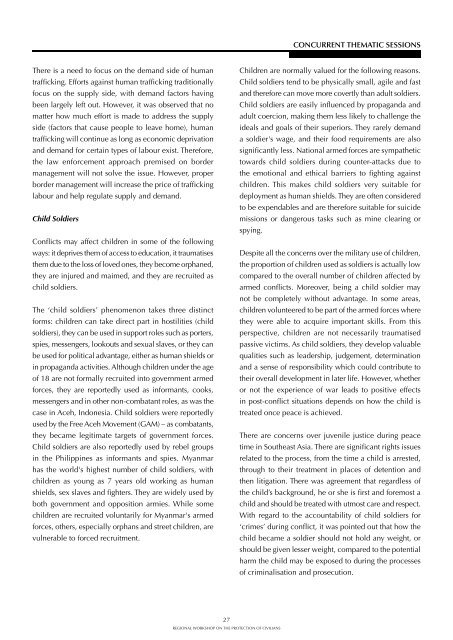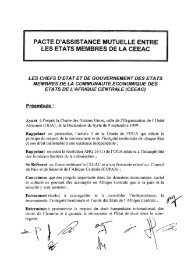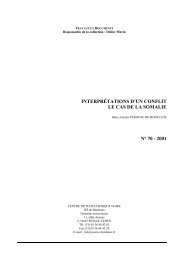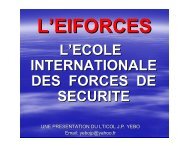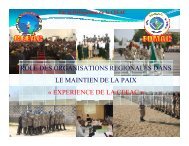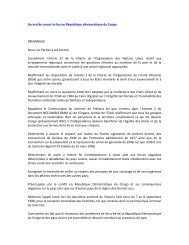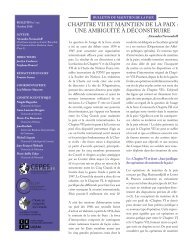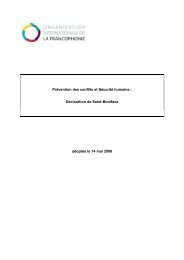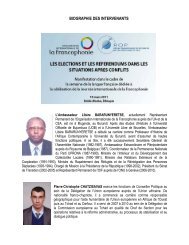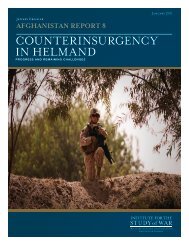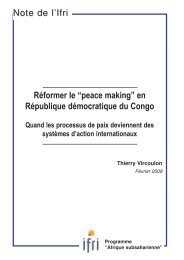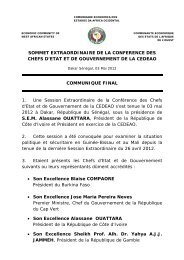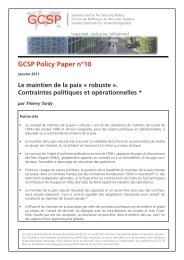Regional Workshop on the Protection of Civilians - S. Rajaratnam ...
Regional Workshop on the Protection of Civilians - S. Rajaratnam ...
Regional Workshop on the Protection of Civilians - S. Rajaratnam ...
Create successful ePaper yourself
Turn your PDF publications into a flip-book with our unique Google optimized e-Paper software.
CONCURRENT THEMATIC SESSIONS<br />
There is a need to focus <strong>on</strong> <strong>the</strong> demand side <strong>of</strong> human<br />
trafficking. Efforts against human trafficking traditi<strong>on</strong>ally<br />
focus <strong>on</strong> <strong>the</strong> supply side, with demand factors having<br />
been largely left out. However, it was observed that no<br />
matter how much effort is made to address <strong>the</strong> supply<br />
side (factors that cause people to leave home), human<br />
trafficking will c<strong>on</strong>tinue as l<strong>on</strong>g as ec<strong>on</strong>omic deprivati<strong>on</strong><br />
and demand for certain types <strong>of</strong> labour exist. Therefore,<br />
<strong>the</strong> law enforcement approach premised <strong>on</strong> border<br />
management will not solve <strong>the</strong> issue. However, proper<br />
border management will increase <strong>the</strong> price <strong>of</strong> trafficking<br />
labour and help regulate supply and demand.<br />
Child Soldiers<br />
C<strong>on</strong>flicts may affect children in some <strong>of</strong> <strong>the</strong> following<br />
ways: it deprives <strong>the</strong>m <strong>of</strong> access to educati<strong>on</strong>, it traumatises<br />
<strong>the</strong>m due to <strong>the</strong> loss <strong>of</strong> loved <strong>on</strong>es, <strong>the</strong>y become orphaned,<br />
<strong>the</strong>y are injured and maimed, and <strong>the</strong>y are recruited as<br />
child soldiers.<br />
The ‘child soldiers’ phenomen<strong>on</strong> takes three distinct<br />
forms: children can take direct part in hostilities (child<br />
soldiers), <strong>the</strong>y can be used in support roles such as porters,<br />
spies, messengers, lookouts and sexual slaves, or <strong>the</strong>y can<br />
be used for political advantage, ei<strong>the</strong>r as human shields or<br />
in propaganda activities. Although children under <strong>the</strong> age<br />
<strong>of</strong> 18 are not formally recruited into government armed<br />
forces, <strong>the</strong>y are reportedly used as informants, cooks,<br />
messengers and in o<strong>the</strong>r n<strong>on</strong>-combatant roles, as was <strong>the</strong><br />
case in Aceh, Ind<strong>on</strong>esia. Child soldiers were reportedly<br />
used by <strong>the</strong> Free Aceh Movement (GAM) – as combatants,<br />
<strong>the</strong>y became legitimate targets <strong>of</strong> government forces.<br />
Child soldiers are also reportedly used by rebel groups<br />
in <strong>the</strong> Philippines as informants and spies. Myanmar<br />
has <strong>the</strong> world's highest number <strong>of</strong> child soldiers, with<br />
children as young as 7 years old working as human<br />
shields, sex slaves and fighters. They are widely used by<br />
both government and oppositi<strong>on</strong> armies. While some<br />
children are recruited voluntarily for Myanmar's armed<br />
forces, o<strong>the</strong>rs, especially orphans and street children, are<br />
vulnerable to forced recruitment.<br />
Children are normally valued for <strong>the</strong> following reas<strong>on</strong>s.<br />
Child soldiers tend to be physically small, agile and fast<br />
and <strong>the</strong>refore can move more covertly than adult soldiers.<br />
Child soldiers are easily influenced by propaganda and<br />
adult coerci<strong>on</strong>, making <strong>the</strong>m less likely to challenge <strong>the</strong><br />
ideals and goals <strong>of</strong> <strong>the</strong>ir superiors. They rarely demand<br />
a soldier's wage, and <strong>the</strong>ir food requirements are also<br />
significantly less. Nati<strong>on</strong>al armed forces are sympa<strong>the</strong>tic<br />
towards child soldiers during counter-attacks due to<br />
<strong>the</strong> emoti<strong>on</strong>al and ethical barriers to fighting against<br />
children. This makes child soldiers very suitable for<br />
deployment as human shields. They are <strong>of</strong>ten c<strong>on</strong>sidered<br />
to be expendables and are <strong>the</strong>refore suitable for suicide<br />
missi<strong>on</strong>s or dangerous tasks such as mine clearing or<br />
spying.<br />
Despite all <strong>the</strong> c<strong>on</strong>cerns over <strong>the</strong> military use <strong>of</strong> children,<br />
<strong>the</strong> proporti<strong>on</strong> <strong>of</strong> children used as soldiers is actually low<br />
compared to <strong>the</strong> overall number <strong>of</strong> children affected by<br />
armed c<strong>on</strong>flicts. Moreover, being a child soldier may<br />
not be completely without advantage. In some areas,<br />
children volunteered to be part <strong>of</strong> <strong>the</strong> armed forces where<br />
<strong>the</strong>y were able to acquire important skills. From this<br />
perspective, children are not necessarily traumatised<br />
passive victims. As child soldiers, <strong>the</strong>y develop valuable<br />
qualities such as leadership, judgement, determinati<strong>on</strong><br />
and a sense <strong>of</strong> resp<strong>on</strong>sibility which could c<strong>on</strong>tribute to<br />
<strong>the</strong>ir overall development in later life. However, whe<strong>the</strong>r<br />
or not <strong>the</strong> experience <strong>of</strong> war leads to positive effects<br />
in post-c<strong>on</strong>flict situati<strong>on</strong>s depends <strong>on</strong> how <strong>the</strong> child is<br />
treated <strong>on</strong>ce peace is achieved.<br />
There are c<strong>on</strong>cerns over juvenile justice during peace<br />
time in Sou<strong>the</strong>ast Asia. There are significant rights issues<br />
related to <strong>the</strong> process, from <strong>the</strong> time a child is arrested,<br />
through to <strong>the</strong>ir treatment in places <strong>of</strong> detenti<strong>on</strong> and<br />
<strong>the</strong>n litigati<strong>on</strong>. There was agreement that regardless <strong>of</strong><br />
<strong>the</strong> child’s background, he or she is first and foremost a<br />
child and should be treated with utmost care and respect.<br />
With regard to <strong>the</strong> accountability <strong>of</strong> child soldiers for<br />
‘crimes’ during c<strong>on</strong>flict, it was pointed out that how <strong>the</strong><br />
child became a soldier should not hold any weight, or<br />
should be given lesser weight, compared to <strong>the</strong> potential<br />
harm <strong>the</strong> child may be exposed to during <strong>the</strong> processes<br />
<strong>of</strong> criminalisati<strong>on</strong> and prosecuti<strong>on</strong>.<br />
27<br />
REGIONAL WORKSHOP ON THE PROTECTION OF CIVILIANS


